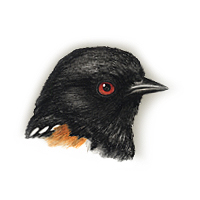|
Field
Guide IDs: BREEDING:
Forest edge,
chaparral, riparian thickets, woodland. 2 broods,
occ 3 in s. DISPLAYS:
From elevated perch
male spreads tail showing white spots, raises wings
and fluffs body feathers; may rapidly spread and
fold tail and wings to flash white
spots. NEST:
Often in scratched
depression, rim of cup flush with ground surface;
of leaves, grass, bark, twigs, rootlets, lined with
fine grass, hair. Female selects site. EGGS:
Grayish to creamy
white, spotted with browns, often wreathed or
capped. 1.0" (24 mm). DIET:
Includes
terrestrial invertebrates, grass and forb seeds,
acorns (esp in winter), berries. Nestlings fed
insects, some fruit. CONSERVATION:
Winter resident,
except in n portion of range; found s to Guatemala.
Frequent cowbird host; apparently does not cover or
eject parasite eggs. NOTES:
Double-scratch
foraging and mouselike run of female as in
Green-tailed Towhee. Female broods nestlings; male
then does most of feeding. Female occ feigns injury
to distract predator from nest. Female may sing in
early spring. Second broods normally produced by
same mates within original territory; first egg
produced 8-21 days after first brood fledges.
Family groups remain together through summer. Often
bathes in dew or fog drip on veg. Forms loose
winter flocks. Fairly common
resident virtually throughout campus, primarily in
dense patches of brushy vegetation. Distributed
fairly sparsely on most of main campus but more
common and widespread in woodland and scrub
habitats near the Dish and around faculty housing.
Less common and widespread than the California
Towhee, and generally restricted to dense
vegetation, unlike California. ESSAYS: Vocal
Functions;
Vocal
Dialects;
Great
Plains Hybrids;
Cowbirds;
Bathing
and Dusting REFERENCES:
Ewert, 1980;
Greenlaw, 1978; Richards, 198lb. |
